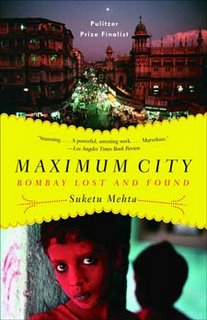 Book Review: I recently finished Suketu Mehta's fantastic book called Maximum City. I couldn't put the book down for many nights. If you have ever spent time in Bombay, or want to, you must read this book. While Suketu can be pretty dark at times, you have to trudge through to the end to get a little light. Sure Mumbai is a mess, but its also amazingly interesting. I don't think I have ever read such an intimate portrait of a city. Here's a snippet from Seriously Sandeep, a more patient blogger than I:
Book Review: I recently finished Suketu Mehta's fantastic book called Maximum City. I couldn't put the book down for many nights. If you have ever spent time in Bombay, or want to, you must read this book. While Suketu can be pretty dark at times, you have to trudge through to the end to get a little light. Sure Mumbai is a mess, but its also amazingly interesting. I don't think I have ever read such an intimate portrait of a city. Here's a snippet from Seriously Sandeep, a more patient blogger than I:The book is divided into several major sections, each focussing on distinct and unique aspects of Bombay: Shiv Sena, Bollywood, the Mumbai police, the Underworld, Prostitution, and Spirituality. These exist in any big city but what distinguishes them from other cities is their uniqueness found only in Bombay.
I agree. It was fascinating reading about the Bar-Girl scenes. I had no idea this world existed - my many trips to Mumbai typically involve the relatively benign hanging out with relatives, the obligatory trip to Elephantus Island, and some tourist wanderings. For the uninitiated, apparently there are all these dancer bar places, where woman act sort of like Bollywood Geishas (i.e. not prostitutes, but the male idealized image of a young Bollywood sari thrusting heart throb) - they master this art of getting rather sketchy but often wealthy fellows to fall in love with them; the men throw tons of money their way, and if they're lucky, eventually get a continuously challenged pseudo-relationship. Equally intriguing were the Bollywood chapters and the gangster interviews; I found the author's following of the pious Jain family perhaps the most interesting.
On the whole, I give this book 4 out of 4 stars. Extremely well written, very captivating, and very original. If I had to bash anything, it was this very dark overall perspective the author seems to have - I would be concerned if this were your only exposure to India.
For those still reading, here's more from Seriously Sandeep:
Suketu Mehta both confirms certain widely-held myths and shatters certain others. For example, I didn’t know that one of the major contributing factors to Bombay’s urban crowdedness is the result of the misdeeds of a handful of powerful builders–the Rahejas are just one of them–who thwarted a well-thought plan to improve Bombay by expanding housing settlements to the West. Also the fact that several “sharp shooters” of the underworld often change allegiances from this don to that only for cash, and not out of loyalty or conviction. Or the fact that Sanjay Dutt’s character comes across as nothing more than a frightened school boy who likes to identify with the “tough guys” in the hope that they’ll protect him from other tough guys/bullies. Mehta traces this attribute to Dutt’s experiences as a school-going boy who used to routinely get beaten by teachers and bullied by his classmates. Hence his fascination with the dons, his passion for guns, and his obsession with bodybuilding, as the author remarks, Sanjay “was built like a brontosaurus.”
His soujourn with Ajay Lal (most names are changed in the book) a high-ranking cop makes for interesting reading. I however, found it hard to believe when Ajay Lal says he has not touched a single paisa as bribe. Blame it on my cynicism or plain mistrust. Yet, it is believable on several counts: Ajay Lal was prominent in unearthing the D-hand in the Bombay serial blasts, and instrumental in solving sensational crimes. His humiliation at the hands of his own department–transfers, inquires, etc–is the price he pays for his honesty. Mehta also exposes the murky details of “criminals in uniform” aka cops who went on a shooting spree, killing even innocent people merely on unfounded grounds of suspicion, shakes you. Overall, the picture you get is that the efficiency of Bombay cops is top class given the severe constraints under which they are forced to work. The author has titled this section as Second best to Scotland Yard, but the characters in this section say it is far superior to Scotland Yard. It is definitely believable.


1 comment:
Interesting read. Bombay is Bombay. Everytime I visit, I find something new- E Dil hai Mushkil Jeena yehaan. Zara bachke zara hatke yeh hai Mumbai meri Jaan. Bombay would perhaps be the most interesting and happening city in India.
Post a Comment